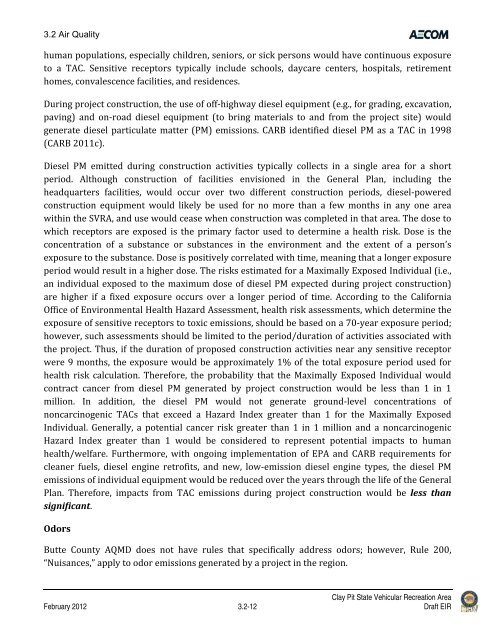Draft Environmental Impact Report - California Off Highway Vehicle ...
Draft Environmental Impact Report - California Off Highway Vehicle ...
Draft Environmental Impact Report - California Off Highway Vehicle ...
You also want an ePaper? Increase the reach of your titles
YUMPU automatically turns print PDFs into web optimized ePapers that Google loves.
3.2 Air Quality<br />
human populations, especially children, seniors, or sick persons would have continuous exposure<br />
to a TAC. Sensitive receptors typically include schools, daycare centers, hospitals, retirement<br />
homes, convalescence facilities, and residences.<br />
During project construction, the use of off‐highway diesel equipment (e.g., for grading, excavation,<br />
paving) and on‐road diesel equipment (to bring materials to and from the project site) would<br />
generate diesel particulate matter (PM) emissions. CARB identified diesel PM as a TAC in 1998<br />
(CARB 2011c).<br />
Diesel PM emitted during construction activities typically collects in a single area for a short<br />
period. Although construction of facilities envisioned in the General Plan, including the<br />
headquarters facilities, would occur over two different construction periods, diesel‐powered<br />
construction equipment would likely be used for no more than a few months in any one area<br />
within the SVRA, and use would cease when construction was completed in that area. The dose to<br />
which receptors are exposed is the primary factor used to determine a health risk. Dose is the<br />
concentration of a substance or substances in the environment and the extent of a person’s<br />
exposure to the substance. Dose is positively correlated with time, meaning that a longer exposure<br />
period would result in a higher dose. The risks estimated for a Maximally Exposed Individual (i.e.,<br />
an individual exposed to the maximum dose of diesel PM expected during project construction)<br />
are higher if a fixed exposure occurs over a longer period of time. According to the <strong>California</strong><br />
<strong>Off</strong>ice of <strong>Environmental</strong> Health Hazard Assessment, health risk assessments, which determine the<br />
exposure of sensitive receptors to toxic emissions, should be based on a 70‐year exposure period;<br />
however, such assessments should be limited to the period/duration of activities associated with<br />
the project. Thus, if the duration of proposed construction activities near any sensitive receptor<br />
were 9 months, the exposure would be approximately 1% of the total exposure period used for<br />
health risk calculation. Therefore, the probability that the Maximally Exposed Individual would<br />
contract cancer from diesel PM generated by project construction would be less than 1 in 1<br />
million. In addition, the diesel PM would not generate ground‐level concentrations of<br />
noncarcinogenic TACs that exceed a Hazard Index greater than 1 for the Maximally Exposed<br />
Individual. Generally, a potential cancer risk greater than 1 in 1 million and a noncarcinogenic<br />
Hazard Index greater than 1 would be considered to represent potential impacts to human<br />
health/welfare. Furthermore, with ongoing implementation of EPA and CARB requirements for<br />
cleaner fuels, diesel engine retrofits, and new, low‐emission diesel engine types, the diesel PM<br />
emissions of individual equipment would be reduced over the years through the life of the General<br />
Plan. Therefore, impacts from TAC emissions during project construction would be less than<br />
significant.<br />
Odors<br />
Butte County AQMD does not have rules that specifically address odors; however, Rule 200,<br />
“Nuisances,” apply to odor emissions generated by a project in the region.<br />
Clay Pit State Vehicular Recreation Area<br />
February 2012 3.2-12 <strong>Draft</strong> EIR








